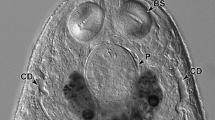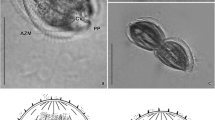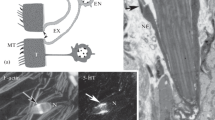Abstract
An electron dense marker, lanthanum nitrate, was injected into the excretory ducts of living plerocercoids ofDiphyllobothrium dendriticum and the observations made by electron microscopy. The contractions of the plerocercoid spread the marker into the excretory system, and the distribution was found to be irregular both within the ducts and from one duct to another. Communication between the smallest ducts and the rest of the excretory system was noted. The marker was also introduced from the surrounding medium, in this case the fixative. It was found to flush into the excretory ducts through the pore in the tail and to be distributed into the ducts in the same way as the injected marker. No other pores were observed through the tegument other than the excretory pore in the tail by either method. In ultrastructure the duct wall is similar to that of other cestodes. The distributive role of the excretory system is discussed, including a comparison between the tegument and the duct wall.
Similar content being viewed by others
References
Baron PJ (1968) On the histology and ultrastructure ofCysticercus longicollis, the cysticercus ofTaenia crassiceps Zeder, 1800 (Cestoda, Cyclophyllidea). Parasitology 58:497–513
Brand T von (1966) Biochemistry of parasites. Academic Press, New York and London
Dougherty RM, DiStefano H, Feller U, Mueller JF (1975) On the nature of particles lining the excretory ducts of pseudophyllidean cestodes. J Parasitol 61(6):1006–1015
Gabrion C, Gabrion J (1976) Etude ultrastructurale de la larve deAnomotaenia constricta (Cestoda, Cyclophyllidea). Z Parasitenkd 49:161–177
Hayunga EG, Mackiewicz JS (1975) An electron microscope study of the tegument ofHunterella nodulosa Mackiewicz and McCrae, 1962 (Cestodea: Caryophyllidea) Int J Parasitol 5:309–319
Hopkins CA, Law LM, Threadgold LT (1978)Schistocephalus solidus: Pinocytosis by the plerocercoid tegument. Exp Parasitol 44:161–172
Howells RE (1969) Observations on the nephridial system of the cestodeMoniezia expansa (Rud., 1805). Parasitology 59:449–459
Lewis PR, Knight DP (1977) Staining methods for sectioned material. In: Glauert AM (ed), Practical methods in electron microscopy. North-Holland Publ Co. Amsterdam — New York — Oxford, p 62–66
Lindroos P, Gardberg T (1982) The excretory system ofDiphyllobothrium dendriticum (Nitzsch 1824) plerocercoids as revealed by an injection technique. Z Parasitenkd 67:289–297
Lumsden RD (1975) Surface ultrastructure and cytochemistry of parasitic helminths. Exp Parasitol 37:267–339
Malmberg G (1971) On the procercoid protonephridial systems of threeDiphyllobothrium species (Cestoda. Pseudophyllidea) and Janicki's cercomer theory. Zool Scripta 1:43–56
Morseth DJ (1967) Fine structure of the hydatid cyst and protoscolex ofEchinococcus granulosus. J Parasitol 53(2):312–325
Oaks JA, Lumsden RD (1971) Cytological studies on the absorptive surfaces of cestodes. V. Incorporation of carbohydrate-containing macromolecules into tegument membranes. J Parasit 57:1256–1268
Oaks JA, Mueller JF (1981) Location of carbohydrate in the tegument of the procercoid ofSpirometra mansonoides. J Parasitol 67(3):325–331
Race GJ, Larsh JE, Esch GW, Martin JH (1966) A study of the adult stage ofTaenia multiceps (Multiceps recialis) by electron microscopy. J E Mitchell Sci Soc 82(1):44–57
Sakamoto T, Sugimura M (1969) Studies on echinococcosis XXI. Electron microscopical observations on general structure of larval tissue of multilocularEchinococcus. Jap J Vet Res 17(3):68–101
Šlais J, Serbus C, Schramlova J (1971) The microscopical anatomy of the bladder wall ofCysticercus bovis at the electron microscope level. Z Parasitenkd 36:304–320
Swiderski Z, Euzet L, Schönenberger N (1975) Ultrastructures du système néphridien des cestodes cyclophyllidesCatenotaenia pusilla (Goeze, 1782),Hymenolepis diminuta (Rudolphi, 1819) etInermicapsifer madagascariensis (Davaine, 1870) Baer, 1956. La Cellule 71(1):7–18
Trimble JJ, Lumsden RD (1975) Cytochemical characterization of tegument membrane-associated carbohydrates inTaenia crassiceps larvae. J Parasitol 61:665–676
Wilson RA, Webster LA (1974) Protonephridia. Biol Rev 49:127–160
Yamane Y, Yoshida N, Yazaki S, Maejima J (1978) Observations on the ultrastructure of the excretory canal of the cestode,Spirometra erinacei. Shimane J Med Sci 2:1–14
Author information
Authors and Affiliations
Rights and permissions
About this article
Cite this article
Lindroos, P. The excretory ducts ofDiphyllobothrium dendriticum (Nitzsch 1824) plerocercoids: Ultrastructure and marker distribution. Z. Parasitenkd. 69, 229–237 (1983). https://doi.org/10.1007/BF00926958
Accepted:
Issue Date:
DOI: https://doi.org/10.1007/BF00926958




